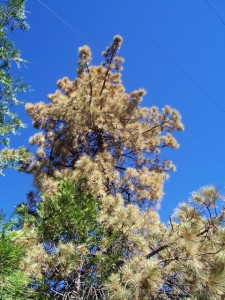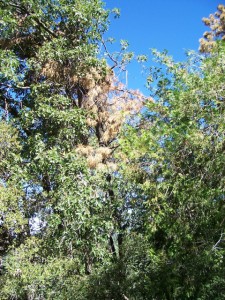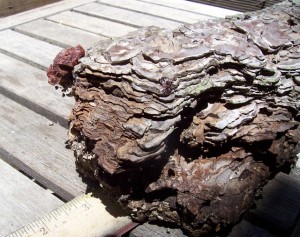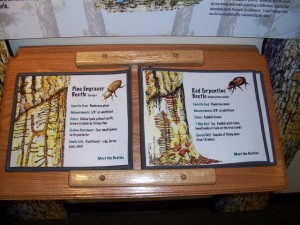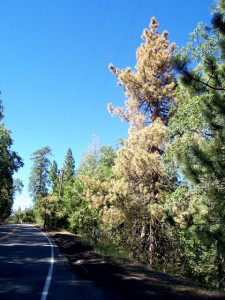
(At R) After touring Loma Linda, Fion wants to attend med school here
By Marcia E. Gawecki
Just two weeks before Spring Break at Idyllwild Arts, a “Cadaver Trip” to Loma Linda University Medical Center was planned. Some admitted to signing up just to get off the hill for the day, while others wanted to get extra science credit. No one really wanted to see a dead body.
Well, maybe two of them did. Caleigh and Fion, two Interdisciplinary Arts majors, were the most calm and interested of the 18 students who attended that day. They weren’t nervous beforehand, walked right up close to the cadaver when it was unveiled and asked the doctor a lot of questions. After graduating next year, Fion is thinking of studying medicine instead of the arts.
“I was really impressed with Loma Linda,” Fion said. “It looked like an excellent school that I might want to go to.”
On the other hand, Caleigh plans to study painting at New York University in the fall, but also wants to study embalming and makeup for the dead.
“I’ve got four more years of art school, and my career may not take off right away,” Caleigh explained. “So I’ll need something that I can rely on for awhile.”
In fact, she had seen a dead body before. “I toured a mortuary once and saw how they get people ready for the funeral,” Caleigh said. “It’s really fascinating.”
She said that she went along on the trip because she was thinking of including art diagrams of internal organs for her senior art show in April.
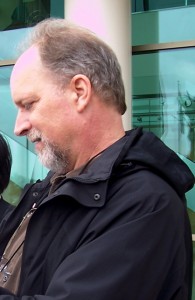
William Waddell hosted the cadaver trip
William Waddell, a faculty science teacher at Idyllwild Arts, hosted the trip. It was his first time to Loma Linda University Medical Center, and he was excited about seeing the new facility.
“Loma Linda Medical Center probably has the largest anatomy facility in the United States,” Waddell said.
Al Newman, who teaches math at Idyllwild Arts, went along for support.
Dr. Benjamin Nava, director of Anatomy, lead the hour-long tour. The campus was busy that week hosting a medical convention, in which Dr. Campbell, one of President Obama’s physicians, was a keynote speaker.
Before entering the three anatomy labs, there were large signs posted: “No photographs please.” One van driver and several students admitted to having cameras with them. They were hoping to get a few pictures to show their friends who were too “chicken” to come.
“For security purposes and the dignity of our patients, we ask that you refrain from taking pictures of the cadavers and the facility,” Dr. Nava said.
The first room they entered was one of the anatomy labs. Just like on medical shows, there were several gurneys lined up in rows, in the cold, sterile-looking operating room. Overhead, large screen TVs could beam the dissection to as many as 200 students. While sheets were draped over the bodies, and there was a strong smell of embalming fluid in the air.
The students huddled together in a large group, eyes wide open, and no one spoke. Several students were holding each other’s hands for support. They were just staring at the bodies, waiting for “the moment” when one would be uncovered.
Dr. Nava must’ve lead many student tours before. Because he showed the Idyllwild Arts students three operating rooms of cadavers, a model storage room, and a plastination room before he uncovered the dead body.
“Plastination is the newest thing in anatomy,” Dr. Nava said, as he handed a plasticized human brain to the students when they were touring the storage room. Because it was made of plastic, some took it readily, while others refused.
“That’s still someone’s brain,” one said. “I’m not going to touch that!”
According to web sites, plastination is a technique used in anatomy to preserve bodies or body parts. The water and fat are replaced by certain plastics, yielding specimens that can be touched, do not smell or decay, and even retain most of the properties of the original specimen.
“We can check these parts out, right Dr. Nava?” Waddell asked as he was inspecting a plasticized chest cavity.
Dr. Nava said that Loma Linda Medical Center is setting up a library in which teachers like Waddell can check out an organ or body part. However, when Caleigh asked if she could check some out to study them for her senior show, she was refused.
It’s only for medical research and teaching purposes, the doctor said.
Along the shelves, there were plasticized arms, feet and ankles, brains and other body parts.
“There’s a great sample of a heart here somewhere,” Dr. Nava said, as he searched the back of the shelves.
“I really want to see a foot,” admitted Kayla, a dance major.
On the table in the narrow room were brains encased in glass and floating in embalming solution.
“When I went to medical school,” Dr. Nava said. “These are all we had to study. Now plastination has made it better for today’s medical students.”
The final stop was a small operating room with a single body draped over it. By that time, the students were relaxed and talking. Some, like Caleigh, came up to the body to get a closer look.
“Can anyone donate their body, or are there certain restrictions?” Caleigh asked. Dr. Nava said that the person couldn’t be too tall because they’d have to fit on the table, and into bins in the storage facility. And for the same reason, they couldn’t be heavier than 300 pounds.
“If a person dies a certain way, can you still accept them?” Caleigh asked.
“If a patient has a certain type of Hepatitis, we cannot accept them,” Dr. Nava said. “We have to protect our students and faculty.”
He added that if certain kinds of cancer have mastesized too far, it’s impossible to dissect the organs in the body, and they’d have to refuse it.
He said that the body that he was about to show the students was dissected for tours such as these.
“We didn’t show you the bodies in the other room because our medical students are working on them,” Dr. Nava said. “And the work they do can be destructive.”
For privacy, he put a smaller drape over the face of the cadaver, but not before a few students saw it. It was an older man with a moustache.
His mouth was open!” exclaimed Sorrelle, a dance major. “Did he die that way?”
“Some medical students were working on dissecting the jaw,” Dr. Nava calmly explained.
He uncovered the body to expose the head, neck, chest and one arm. The skin had turned brown, and the nails were yellow. The left arm had been dissected to show the veins and main arteries.
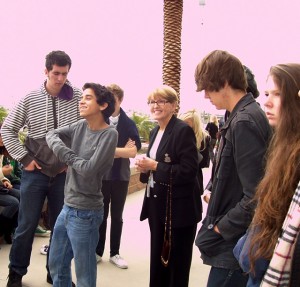
Students went to get extra credit
Like the hood of a car, he opened up the chest cavity to show the heart, lungs, stomach and other organs.
“Like most people living in the Inland Empire, the exhaust has affected his lungs,” Dr. Nava said, revealing some dark spots.
Dr. Nava reached back and checked to see if the cadaver had a gall bladder, and also showed the small and large intestines, the appendix and colon.
Each time that he showed a new part, he asked the students what it was. One stumped them, however. It was a small organ in the upper left quadrant of the abdomen.
“It has to do with red blood cells and the immune system,” Dr. Nava said. “I’ll treat anyone to dinner at the Gastrognome, if you can figure out what this is.”
“His kidney?” Newman guessed. No one seemed to know.
“It’s the spleen,” Dr. Nava said.
He concluded his tour by talking briefly about the benefits of body donation to Loma Linda Medical Center.
“You know funerals can cost thousands of dollars,” he said. “But donating your body to Loma Linda only costs $300, and Social Security will pay for it.”
The cost covers the transportation of 100-mile radius, embalming, storage, and final burial.

Conner liked the cadaver trip
When the tour was over, the students, unfazed, talked about where they were going to eat lunch.
“I think I’m going to donate my body to science,” said Conner, a music major. “It just makes sense.”
Copyright 2010 Idyllwild Me. All rights reserved.

